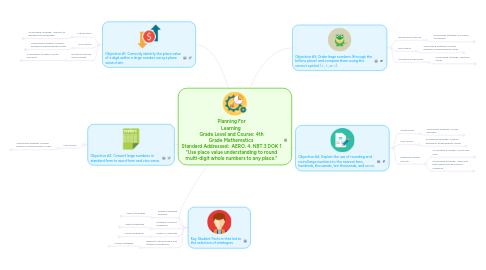
1. Objective #2: Convert large numbers in standard form to word form and vice versa.
1.1. Mini Lesson
1.1.1. Scaffolding Strategy: Gradual Release of Responsibility Model
1.1.1.1. "I Do"- Place flash cards with large numbers on the game board. Assign a value to each based on the level of difficulty. Show students with two examples, from standard form to word form and vv. Show how to use the place value chart as a tool.
1.1.1.2. "We Do"- Work on two practice flash cards as a class.
1.1.1.3. "You Do"- Play in partners.
1.1.1.3.1. Scaffolding Best Practice: Intentional small group/partner work.
2. Objective #1: Correctly identify the place value of a digit within a large number using a place value chart.
2.1. Introduction
2.1.1. Scaffolding Strategy: Connect to Background Knowledge
2.1.1.1. Introduce concept of place value by discussing value.
2.2. Mini Lesson
2.2.1. Scaffolding Strategy: Gradual Release of Responsibility Model
2.2.1.1. "I Do"- Show how to use a place value chart to identify place value of any one digit.
2.2.1.1.1. Scaffolding Best Practice: Show students the outcome before they do it
2.2.1.1.2. Scaffolding Best Practice: Use of graphic organizers and visual aids (place value chart projected on the board and individual hand out).
2.2.1.2. "We Do"- Practice problems as a class, students show their work and write answer in individual white boards
2.2.1.2.1. Scaffolding Best Practice: Use think aloud to model thought process.
2.2.1.3. "You Do"- Practice problems (individual work and discuss answers with a partner)
2.2.1.3.1. Scaffolding Best Practice: Weave in think-pair share
2.3. Activity to Review Skill/Concept
2.3.1. Scaffolding Strategy: Visuals and Relia
2.3.1.1. Students construct a Human Place Value Line using construction paper signs with the word for each place value from ones to one hundred billion.
3. Key Student Factors that led to the selection of strategies
3.1. English Language Learners
3.1.1. Useful Strategies
3.1.1.1. 1. Directions written down and presented in numbered sub tasks
3.1.1.2. 2. Practice speaking and writing
3.1.1.3. 3. Vocabulary section in their math notebook.
3.2. Different Levels of Readiness
3.2.1. Useful Strategies
3.2.1.1. 1. Tiered activities
3.2.1.2. 2. Alternative projects and activities i.e. Individual research project, I pad use, IXL and other educational games.
3.3. Variety of Interests
3.3.1. Useful Strategies
3.3.1.1. Summative Assessment Projects that give students the freedom to research a topic of their choice
3.4. Different Learning Style and Multiple Intelligences
3.4.1. Useful Strategies
3.4.1.1. Integrate activities in to the lesson that reinforce concepts in multiple ways.
4. Objective #3: Order large numbers (through the billions place) and compare them using the correct symbol (>, <, or =).
4.1. Introduction Activity
4.1.1. Scaffolding Strategy: Pre-Teach Vocabulary
4.1.1.1. Introduce ">" and "<" symbols by using the metaphor of a hungry crocodile.
4.2. Mini Lesson
4.2.1. Scaffolding Strategy: Gradual Release of Responsibility Model
4.2.1.1. "I Do"- Draw and color hungry crocodiles with > and < symbols and show students step by step how to compare two large numbers and write down the comparison using these symbols.
4.2.1.1.1. Scaffolding Best Practice: Use of Visual Aids
4.2.1.2. "We Do" - Practice using the crocodiles on problems as a class.
4.2.1.2.1. Scaffolding Best Practice: Use of Visual Aids
4.2.1.3. "You Do"- Practice problem with shoulder partner
4.2.1.3.1. Scaffolding Best Practice: Intentional Partner Work
4.3. Formative Assessment
4.3.1. Scaffolding Strategy: Question Cards
4.3.1.1. "What Stuck With You" Post-It with the answer to an assessment question before leaving class
5. Objective #4: Explain the use of rounding and round large numbers to the nearest tens, hundreds, thousands, ten thousands, and so on.
5.1. Introduction
5.1.1. Scaffolding Strategy: Visuals and Relia
5.1.1.1. Construct number line outside using real world objects as the different limits
5.2. Mini Lesson
5.2.1. Scaffolding Strategy: Gradual Release of Responsibility Model
5.2.1.1. "I Do"- Teach students how to set up a number line and how to use it as a visual aid to round.
5.2.1.1.1. Scaffolding Best Practice: Use of Visual Aids
5.2.1.2. "We Do"- Practice problems as a class, students solve for the problem on individual white boards.
5.2.1.2.1. Scaffolding Best Practice: Intentional Group Work
5.2.1.3. "You Do"- Exit card
5.2.1.3.1. Scaffolding Best Practice: Question Cards
5.3. Additional Review Activity
5.3.1. Scaffolding Strategy: Visuals and Relia
5.3.1.1. Video
5.3.2. Scaffolding Strategy: Hand outs that match diverse levels of readiness
5.3.2.1. Assign 5 activities, of increasing difficulty. Students must complete at least 1, 2 and 3.

